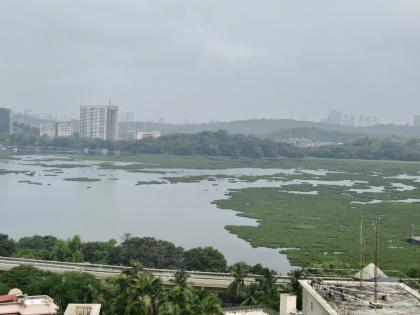Environmentalists Urge Devotees to Avoid Immersions in Polluted Powai Lake Ahead of Ganeshotsav
By Lokmat English Desk | Updated: July 21, 2025 16:33 IST2025-07-21T16:32:39+5:302025-07-21T16:33:27+5:30
Pointing out that Powai Lake continues to be filled with a whopping 18 million-litres-a-day of untreated sewer, environmentalists have ...

Environmentalists Urge Devotees to Avoid Immersions in Polluted Powai Lake Ahead of Ganeshotsav
Pointing out that Powai Lake continues to be filled with a whopping 18 million-litres-a-day of untreated sewer, environmentalists have called upon the Ganesh and Durga Mata devotees not to use the waterbody for the immersion of idols during the forthcoming festivals. The Brihanmumbai Municipal Corporation (BMC) has just about started the process of floating tenders for the diversion of the raw sewer and setting up treatment plants at the lake. But the fact remains that the waterbody is terribly filthy with the untreated sewer flowing in, NatConnect Foundation, which, along with local resident groups, spearheaded a campaign to get the lake cleaned. “It is unfortunate that the ignorant devotees continue to throng the lake,” NatConnect director B N Kumar said.
BMC itself has admitted that 18 million litres of filth goes into the lake, but devotees in general are either ignorant or unmindful of this dark aspect, Pamela Cheema, chairperson of BMC-mandated Advanced Locality Management (ALM) group, regretted. NatConnect has addressed emails to both Police and Municipal commissioners to start chalking out the guidelines right now as the Ganesh festival is barely a month away and the immersions would start from Day 2 of the event. “As devotees of Ganesha and Durga, we feel really hurt when we have to immerse the idols in filthy waters like the Powai Lake,” said Milan Bhat, an ALM member and a resident of Hiranandani Gardens. Following a concerted campaign and emails to the state government and BMC, the civic body has initiated the process of cleaning the lake by deploying harvester machines, which was grossly inadequate to clean the fast-growing hyacinth, which is detrimental to the lake’s biodiversity, Cheema said.
While the resident groups' Ganesh idols are being immersed in the artificial pools, the large ones are still being taken to the lake, said Geetanjali Dhulekar, another resident of Powai supporting the public awareness drive. The activists have therefore suggested to the authorities to make larger pools for big ‘Saarvajanik’ festival idols. The right message about eco-friendly Ganesh idols must percolate down to the idol makers, apart from the worshippers, the latest messaging on #IlovePowaiLake social media handle said. The online campaign - SOS! Powai Lake Chokes Under Mumbai Sewer - has already garnered 16,000 views and 1,500 shares and 3,000 plus signatures.
Meanwhile, the Centre has stepped in as environmentalists have raised an alarm against the 660-hectare Powai Lake, which has turned into a ‘reservoir of filth’ with the inflow of 18 million-litres-a-day of untreated sewer. Swiftly responding to a complaint filed by environment watchdog NatConnect Foundation through the PMO public grievances website, the Union Ministry of Environment, Forest and Climate Change (MOEFCC) has asked the Maharashtra Environment Director to take “necessary action”. Pankaj Verma, Scientist-F in the MOEFCC, signed the email to the State, attached the complaint copy, which pointed out that urgent measures are needed to secure the wetland and then conserve it.
BMC has itself admitted as much as 18 million litres of sewer drains into the wetland and “planned” permanent measures to divert the muck, Kumar said. All the promises by the civic authorities to clean the lake have remained only on paper, and there is a semblance of action to clear hyacinth from the lake now, after the activists raised their alarm. The major wetland, which was once a source of drinking water, is now full of hyacinth due to the unchecked sewer flow. NatConnect has, therefore, requested the Centre’s intervention to take steps to protect the flora and fauna and conserve the biodiversity such as crocodiles of this major wetland.
Open in app